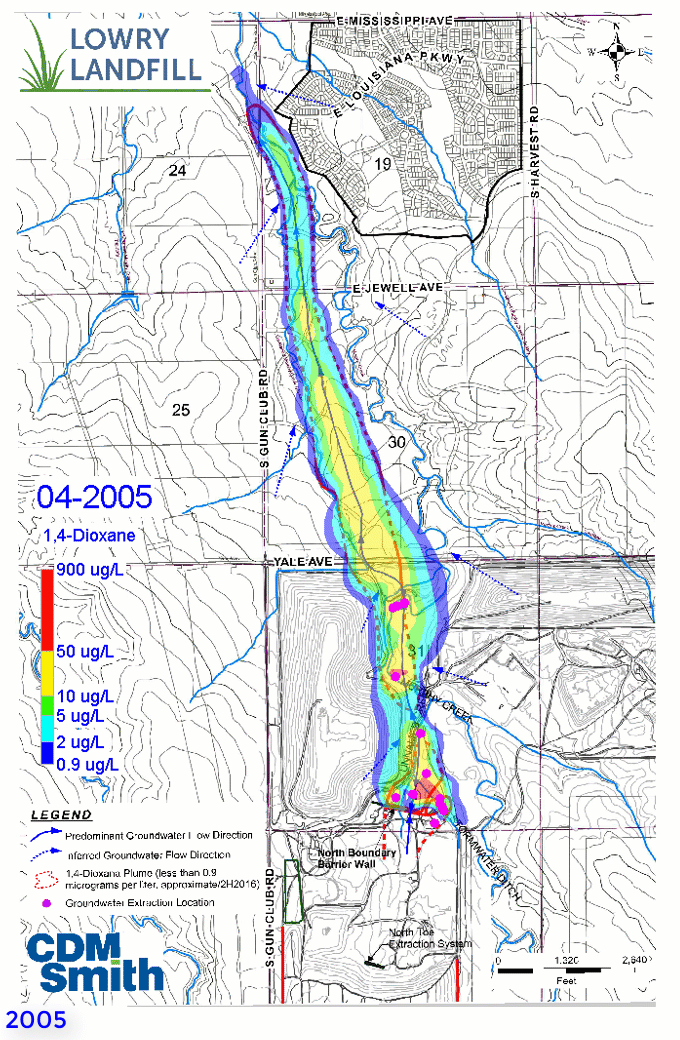The Site is Safe.
Industrial waste disposal at the Lowry Landfill ended forty years ago. Because waste will remain at the Site, by law the EPA is required to conduct mandatory five-year remedy reviews to ensure all activities are working as designed and to issue a finding that the remedy is “protective of human health and the environment.”

Safety Overview: Remediation, Containment, Collection, Treatment, Monitoring
A number of methods have been implemented to protect the public. These include remediation, containment, collection, treatment, and monitoring of contamination in the soil, air, and water.
Containment methods – capping the landfill with clay, underground barrier walls to prevent groundwater flow from the site, extraction of groundwater from trenches and wells, an onsite water treatment plant and an innovative system that converts landfill gases into energy – protect the surrounding environment and human health.
Overseen by federal and state regulators, the site’s remediation and containment plan has been in place and operating for decades. Every five years, the EPA evaluates the remedy at the Superfund site to ensure it is now and in the future protective of human health and the environment. The agency’s most recent five-year review can be found here.
The landfill gas treatment system collects gas that is naturally generated from the decomposition of the landfill wastes and prevents its release, ensuring that the public is not exposed to landfill gas through the air or subsurface migration. Additionally, all the surrounding businesses and residential areas receive drinking water from the City of Aurora and East Cherry Creek Valley Water and Sanitation District, with the exception of two properties served by private wells that have tested clean.
In the 2007 and 2012 Five-Year Reviews (FYR), the EPA concluded that the site has effectively protected humans and the environment from any type of potential exposure.
In the 2017 FYR, protectiveness was deferred to gather more information regarding shallow groundwater and deep groundwater and any risks associated with the presence of a groundwater plume north of the site that has detectable traces of 1,4 dioxane.
In the summer of 2020, the EPA published a 1,4 dioxane risk summary in collaboration with the CDPHE, which concludes that there is no significant exposure/risk from the concentrations detected, even under (these) highly conservative, unlikely, and hypothetical exposure scenarios. In February 2021, the EPA published an amendment to the 2017 FYR stating that the remedy at the Site has been determined to be “short-term protective” of human health and the environment.
In the summer of 2020, the EPA published a 1,4 dioxane risk summary in collaboration with the CDPHE, which concludes that there is no significant exposure/risk from the concentrations detected, even under (these) highly conservative, unlikely, and hypothetical exposure scenarios. In February 2021, the EPA published an amendment to the 2017 FYR stating that the remedy at the Site has been determined to be “short-term protective” of human health and the environment. Additional information regarding the EPA’s statement can be found here:
In Summer 2021, EPA and CDPHE formed a consensus opinion that the remedy components at the site are achieving their objectives and operating as designed.
This consensus opinion was developed in part after the finalization of the following studies:
- North End Groundwater Investigation and North End Conceptual Model
- This model identified extent of a 1,4 dioxane plume.
- North End Risk Assessment
- Concluded that there is no significant exposure/risk from the concentrations of 1,4 dioxane detected even under highly conservative, unlikely, and hypothetical exposure scenarios that were assessed.
- 3-D Visualization and Analysis Mode
- Allowed team to show site geology groundwater and containment beneath the landfill.
- Potable Water Cessation
- Effectiveness Evaluations of Remedial Components
- Review of these led to conclusion that the remedy at the site was effective and operating as designed.
- Conceptual Model
In sum, the following points can be made about safety of the site:
Groundwater Monitoring
More than 500 monitoring wells extending into both shallow and deep aquifers have been installed within and outside the site to ensure the community is protected. A groundwater monitoring system at the Site tracks the movement and direction of the water, and an onsite water treatment plant operates 7 days a week, 24 hours a day, 365 days a year to treat contaminated water. Underground barrier walls extending to the bedrock prevent contaminated water from leaving the Site and uncontaminated groundwater from entering the Site.
The City of Aurora and the East Cherry Creek Valley Water and Sanitation District provide water to all the residents and businesses in the area, with the exception of two properties served by private wells that have tested clean. As a result, the public should not have any concerns with their drinking water, according to the EPA.
Through its groundwater monitoring system, data is meticulously evaluated to respond to any potential changes in the movement and direction of groundwater. To date, these evaluations show that the groundwater remedy initiated nearly four decades ago continues to effectively protect the public and the environment.

North End Monitoring

Colorado has some of the strictest groundwater standards in the country. In 2005, the Colorado Water Quality Control Commission established a new groundwater standard for 1,4 dioxane of 6.1 ppb (parts per billion). Today, the Colorado groundwater standard is 0.35 ppb, below even what analytical laboratories can accurately measure.
1,4 dioxane is a man-made substance used as an industrial solvent. It is still used today in paints and varnishes and can be found in some cosmetics, deodorants, toothpastes, cleaning products, and soaps. The EPA has classified it as a “probable human carcinogen.”
New technological advancements capable of detecting and measuring 1,4 dioxane at the new standards found 1,4 dioxane north of the Site which indicates the remedy components are effectively controlling the plume.
Click to view an animated image of 1,4 dioxane concentrations 2005-2020.
The EPA found:
There is no significant health risk associated with the surface water or groundwater.
The water is not a drinking water source and the risk from occasional contact with contaminated groundwater entering Murphy Creek is insignificant. Anyone who comes into contact with creek water or wades in the creek is not in danger.
The 1,4 dioxane is residual contamination from the site before cleanup and containment began and before 1,4 dioxane was a known or detected contaminant of concern and began being removed at the site’s water treatment plant.
The groundwater extraction and treatment response at the site has significantly decreased the 1,4 dioxane concentrations, and they continue to decline. Please see the map at the left to view the concentration decreases from 2005-2020. The magenta dots represent the groundwater extraction wells.
Since 2005, Colorado has decreased the groundwater standard ten-fold, going from 6.1 ppb to 0.35 ppb. Technology has not advanced to a point where 1,4 dioxane can be consistently measured at that low level, so the site must comply with a 0.9 ppb standard, which can be reliably measured. The dark blue shade on the map illustrates the extent of 1,4 dioxane contamination at a concentration level of 0.9 ppb.
For the most up-to-date information on North End Monitoring Results, please go here.

